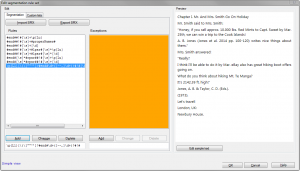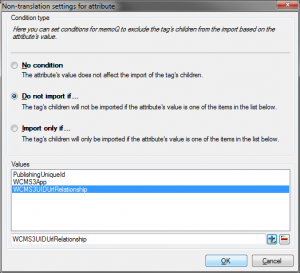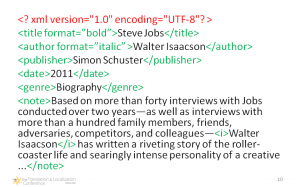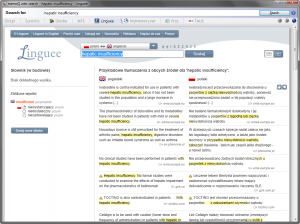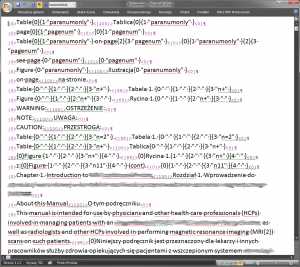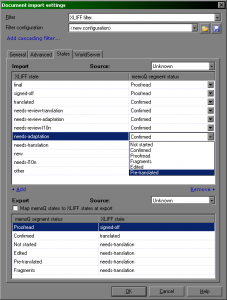Tweet If you happen to translate text with numbered references, you’ve probably encountered problem with incorrect segmentation when the reference number is placed just after end of sentence period, like this: This is an example sentence.² With a second sentence added. In most cases the above sentences will be imported to CAT tools as a single …
Category: Wskazówki
Aug 02
Akronimy w kartach charakterystyki (MSDS)
Tweet Dostałem ostatnio zlecenie, które polegało na przetłumaczeniu sporawej listy akronimów stosowanych w kartach charakterystyk i dokumentacji pokrewnej. I choć często tłumaczę dokumenty z tej dziedziny, wykonanie zlecenia zajęło mi nieproporcjonalnie dużo czasu. Ukończona lista została dodatkowo zweryfikowana i poprawiona w ramch uprzejmości przez nieznanego mi kolegę po fachu (dziękuję). Zainspirowany zleceniem skompilowałem nieco większą …
Jul 06
XML translation – part 2: memoQ
In my previous post I’ve described what is XML, what is it for and what are the particular components. This time I’m going to show you how to properly import almost any XML file into memoQ for translation. I’m going to reference the files described in previous part, so you might want to look there for comparison and file structure description.
Jun 22
XML translation – part 1: introduction
Tweet The XML has a bad reputation amongst translators – quite often it’s being perceived as something complicated and terribly difficult to translate. However, armed with the basic knowledge of the XML file structure and modern translation environment tools it’s actually usually very easy to correctly translate XML. This is the first installment of a …
May 25
Localizing iOS .strings files with memoQ
One of the biggest buzzwords/trends in localization is currently “mobile”. And as the buzzwords go, this one is justified – there’s a lot of content being localized for mobile devices. And one of the important part of this content is the UI of mobile applications. If a developer wants to sell internationally, he/she should provide localized version of the app. This gives us a job, but also a challenge.
May 18
Gdzie znaleźć terminologię
Wywołano mnie do tablicy pytając listownie o dwu- lub wielojęzyczne glosariusze dostępne w Internecie, najlepiej w formacie XLS lub CSV. To bardzo ciekawe pytanie, ponieważ dotyczy jednego z najważniejszych aspektów pracy tłumacza – terminologii. Skąd „brać” terminologię do tłumaczeń, zwłaszcza dotyczących specjalistycznych dziedzin?
Feb 25
Raport z redakcji w kilka kliknięć
Ostatnio coraz częściej oprócz tłumaczenia zajmuję się redakcją. A po redakcji czasem trzeba udokumentować wprowadzone zmiany, zwłaszcza jeśli było ich dużo. Co prawda nowsze programy CAT dysponują funkcją śledzenia zmian (dostępna np. memoQ czy Trados Studio), to jednak przygotowanie raportu w formie czytelnej poza określonym programem, choć nieskomplikowane, jednak wymaga trochę pracy. Na szczęście istnieją narzędzia, które służą właśnie do obrazowania zmian między dwoma wersjami dokumentów dwujęzycznych.
Nov 11
Karta charakterystyki substancji (MSDS): glosariusz
Karta charakterystyki substancji, czasem nazywana kartą charakterystki substancji niebezpiecznej, po angielsku Material Safety Data Sheet (MSDS), to, cytując wikipedię: ädokument zawierający opis zagrożeń, które może spowodować określona substancja lub mieszanina chemiczna, a także podstawowe dane fizyko-chemiczne na jej temat. Jej podstawowym celem jest informowanie o potencjalnych zagrożeniach związanych z daną substancją (mieszaniną), metodach ich zapobiegania i procedurach jakie należy wykonać w razie wystąpienia skażenia opisywaną substancją (mieszaniną).”
Sep 27
Dealing with Sajan TMS exports
Tweet One of my end clients recently introduced Sajan TM management system. As a result, instead of Trados TMs and TTX files which were a standard previously, I began to receive jobs as an Excel files, containing source segments and pre-translation (from 80% matches up) in separate columns. Additionally there’s a column with TM match …
May 22
SDLXLIF in memoQ, or There and Back Again
Trados Studio as an internal format uses it’s own flavor of XLIFF, namely SDLXLIFF. Since these files generally adhere to quite loosely defined XLIFF standard, it is easy to open them in other tools supporting XLIFF (particularly in memoQ), translate them and insert translated file back into Studio project. Unfortunately all data on matching and segment statuses are coded in Trados-specific way, so we’ll lose this information when switching tools. Fortunately, there’s a way to keep at least segment states.

